吃与活
科学地吃,健康地活
正文
关于周福满饮食方案,我时常遇到两种不同意见。老宋(瘦)说:“周福满列举的糖尿病人的例子都是很胖的。我有个朋友一点也不重,吃着均衡饮食,却得了糖尿病,这是怎么回事?”小庞(胖)则这般说的:“我肉吃得多,胖点,但不仅没有糖尿病,身体各项指标都好得很。”两种情况都是实情,我也见到过。怎么解释呢?我所知有限,就只好查查文献了。
一查文献,发现研究人员对这两种情况还真有一些探讨。老宋的朋友的情况很可能是“代谢肥胖而体重正常”(Metabolically obese normal weight);小庞的情况可能是“代谢正常却身体肥胖”(Metabolically healthy obese)。关于这方面的研究有一篇综述写得很好,我先摘要介绍一下 (14)。
韦伯氏字典关于肥胖的定义是身体里脂肪的过多积累和贮存。但临床关于肥胖与否的测量最初是量一定身高下的体重,后来发展成体重指数(BMI:Body Mass Index,体重/身高的平方,单位是公斤/平方米,大于25为超重,大于30为肥胖)。肥胖当然更应该用脂肪的含量来定义,比如脂肪含量超过体重的25%(男)或35%(女)为肥胖。但由于测BMI远远比测脂肪含量容易,所以BMI被广泛运用。有人对BMI正常的人的脂肪含量进行了测量,在男性中数据从5.6%到31.2%,在女性中从4.6%到51.1% (8)。所以用BMI来衡量肥胖是很不精确的。这很容易忽略了这样一些人:他们体重正常甚至偏瘦,BMI小于25,但脂肪含量却很高。这些人往往更容易得糖尿病与心血管疾病。
Ruderman等人早在1981年就报导他们发现一些体重正常的人患二型糖尿病,过早地患冠心病,高血压,以及伴有高胰岛素的高甘油三酯等症状 (18)。他们发现这些异常不是由于皮下脂肪过多造成的。相关研究表明体重正常而代谢肥胖的人很可能是脂肪分布的问题:他们的脂肪主要分布于内脏而不是皮下。
2006年De Lorenzo 等人报道了体重正常的人的脂肪含量与代谢异常的相关性。他们用“正常体重肥胖”(NWO:normal weight obesity)来描述那些体重正常(BMI小于25)而脂肪含量超过30%的人 (3)。代谢肥胖而体重正常的人应该是正常体重肥胖的人当中的一部分。研究表明正常体重肥胖的妇女代谢缓慢,耗氧降低,心血管疾病风险因素上升 (3) 。有一个有6171个体重正常的人参加的研究发现,脂肪含量高的人的高密度胆固醇(HDL)低,而低密度胆固醇(LDL),甘油三酯,apoB/A-I比,高敏C-反应蛋白 和瘦素(leptin)的水平都高;胰岛素敏感性也与脂肪含量成反相关性 (16)。
另外,在正常体重的人中,多种炎症因子也与随着脂肪含量的增加而增加 (2)。正常体重肥胖的人的与正常体重而不肥胖的人相比,氧化应激(oxidative stress)增加,而还原性的谷胱甘肽和一氧化氮代谢产物则降低 (4)。另外,正常体重肥胖的人也表现出与心衰有关的左心室功能障碍 (22),得代谢综合症的可能性增加了四倍 (下图),得心血管疾病死亡的可能性增加了2.2倍 (16)。一个韩国的研究表明在代谢肥胖而体重正常的人群中,肌肉含量低的人很多 (10) ;另一个说代谢肥胖而体重正常的男人得结直肠癌的风险增加 (9)。
(图:正常体重肥胖的男性代谢综合症指标与脂肪含量的关系)
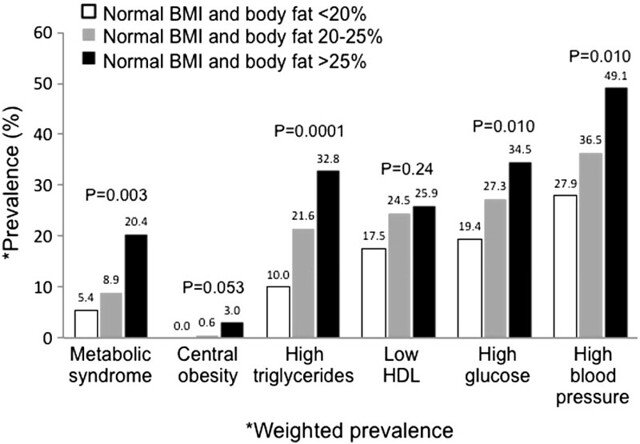
(图:正常体重肥胖的女性代谢综合症指标与脂肪含量的关系)
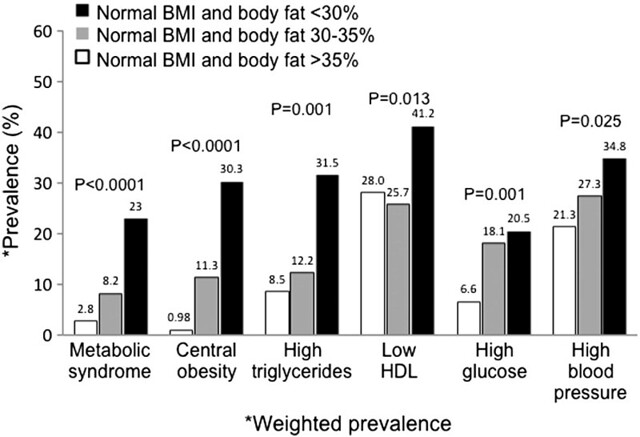
与“代谢肥胖而体重正常”相对应,还有一类 “代谢正常却身体肥胖”(Metabolically healthy obese)的人。他们肥胖,但并不显示出典型的与肥胖相关的代谢紊乱 (15)。在脂肪含量相同的肥胖绝经妇女中,代谢正常的人的内脏脂肪含量要比代谢不正常的人少近一半 (7)。代谢正常却身体肥胖的人的体力活动多于代谢不正常而肥胖的人,身体素质也高。但一般认为,一旦当他们停止了高水平的活动,他们也将成为代谢不正常而肥胖的人。
下表对上述肥胖类型的特征作了一个总结 (14);有关总结也见于本文最后一图 (1)。
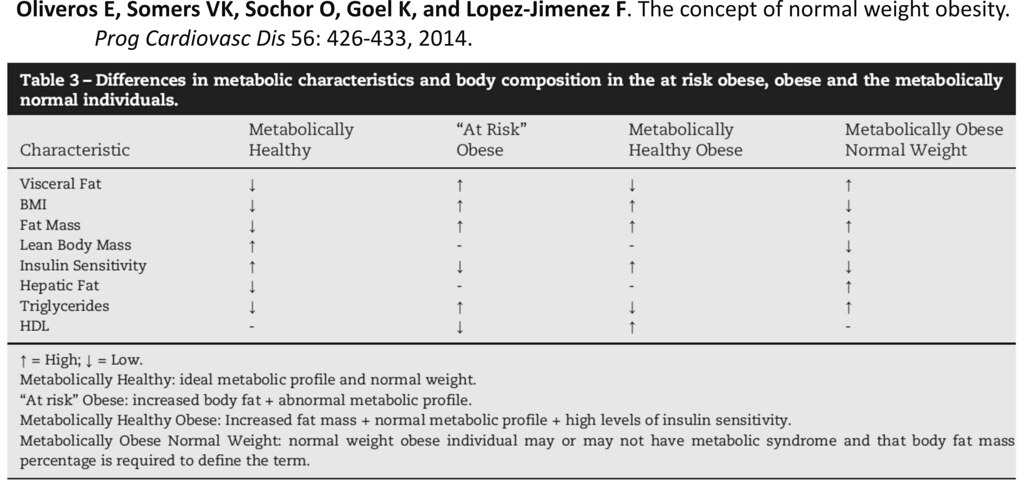
与西方人相比,亚洲人得糖尿病的风险在BMI较低时就开始增加 (13; 20)。同样的BMI,东亚人的脂肪含量和内脏脂肪都高于西方人 (13)。一项对比研究表明,中国人(包括来自大陆,台湾和香港的人)与欧洲裔,北美土著,和南亚裔相比,内脏脂肪含量最高 (11)(下图)。在对台湾的89056位二型糖尿病的患者的数据统计分析后发现,BMI低的人的死亡率(包括癌,糖尿病综合症,以及其它原因引起的死亡)反而更高 (19)。这些BMI低的人很可能内脏脂肪含量并不低。美国人可能远比中国人的肥胖程度高,死亡率最高的是代谢异常而身体也肥胖的那部分人 (见最后一图)。而上述结果很可能意味着在中国人中代谢异常而体重正常的人可能比那些代谢异常而身体肥胖的人更不健康。
[欧洲裔,北美土著,华裔,和南亚裔内脏脂肪组织量的比较 。浅色:男;深 色:女。详情见文献(11)]
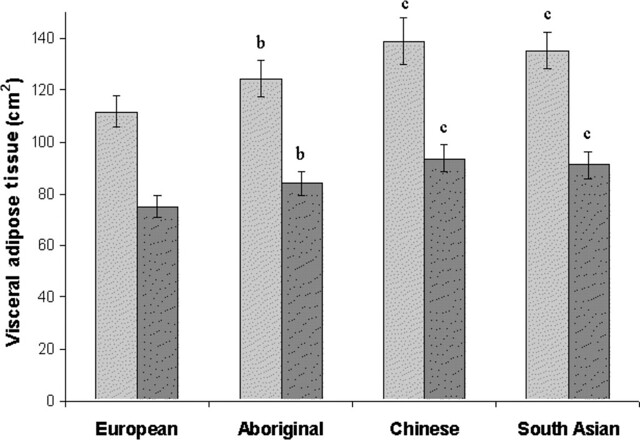
有多少人是“健康”的胖子和不健康的“瘦子”呢?根据Wildman等人的一项研究估计,在美国大约10%的成年人肥胖而又健康, 而8%的成年人体重正常但是不健康。相比之下,26%的成年人体重正常身体健康,而21%的成年人肥胖而不健康 (1; 21)(见下图)。最近发表的一项对2764名30-90岁的中国人的约44个月的跟踪研究表明,“代谢正常而身体肥胖”和“代谢肥胖而体重正常” 的人所占的比例分别是:男性22.9% 和7.6%,女性26.2和6.0% (12)。根据这个人数有限的研究,“代谢正常而身体肥胖” 的中国人的比例似乎比美国人要高。
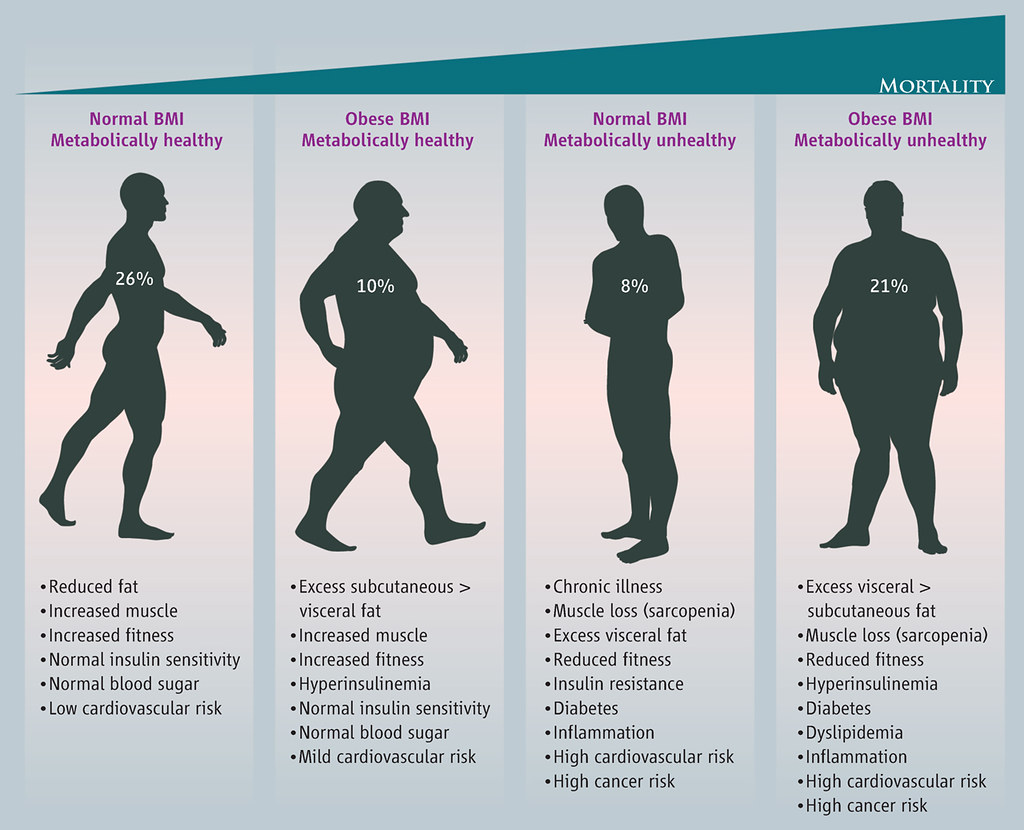
是不是“代谢正常身体肥胖”的人就没有健康问题呢?根据对7765个成年中国人的研究表明,“代谢正常身体肥胖”者的非经典心血管疾病的风险因素和内脏脂肪指数要比代谢健康的正常人高 (5)。另外,近一半“代谢健康身体肥胖”的日本人可检查到脂肪肝 (6)。但不可否认,的确有一些肥胖而身体非常健康的人。
如果您觉得自己是“体重正常肥胖”的人,怎么办呢?我觉得安吉利娜朱丽(Angelina Jolie)是一位值得学习的榜样。她由于基因变异的缘故患乳腺癌的机率很大,为了小孩不失去妈妈,作为一个明星的她就毅然割乳防癌。您如果遗传不佳,当做出努力,改变自己。实验表明这些体重正常而代谢肥胖的病人的症状可以通过限制能量摄取和减肥来改善。四到十二周的节食和锻炼便可以改善他们的代谢肥胖症状 (17)。你要做的,简单地说,就是“减肥增肌”,即把多余的脂肪甩掉,同时增加肌肉的含量。这样在体重不变的情况下,身体的组成得到改善,代谢情况将随之改善。减肥的方式我推荐周福满饮食方案,增肌可通过力量训练。具体怎么做,俺不是行家,请咨询有关专业人员。对于体重轻的人周福满建议多吃坚果豆类加上锻炼来增加体重。我在吃为了活[31]健康篇:怎样健康地增加体重(http://blog.wenxuecity.com/myblog/66789/201410/14362.html)中介绍过周的建议。对于通过锻炼增加肌肉的人来说,我认为要适当增加饮食里蛋白质的量,包括动物来源的蛋白,如鸡蛋白,鱼,瘦肉等。克林顿可能也是一个内脏脂肪含量高的人,他是通过专门配制的蛋白粉来补充蛋白的。待肌肉达到预定水平以后,要减少蛋白摄入量,以维持正常体重。
通常所说的梨形体型与“代谢正常身体肥胖”可能有一定的对应性。同样“代谢肥胖体重正常”可能对应苹果体型,对应的程度不得而知。腰围处的脂肪也很可能与内脏脂肪有一定对应关系。这些都是我的臆测,没有任何实验依据。我相信代谢肥胖体重正常的人和代谢正常身体肥胖的人一定有其遗传基础,希望这个谜能很快被揭开。
如果小庞给你传授养生经验,告诉你高脂饮食对身体有益,你应该看看自己是不是“健康的胖子”。如果你属于“正常体重肥胖”的类型,高脂饮食大概是有害无益。同时也要提醒小庞一句,有好的基因也要注意饮食健康,不是有近一半的“健康的胖子”有脂肪肝吗?“健康的胖子”减肥也有助于提高健康状态。另外常有人宣传百岁老人的饮食,俺觉得百岁老人大多数是恰好有得天独厚的遗传组合。你吃他们的饮食多半活不到他们的年纪,就如同你使用西施/赫本/高圆圆等天生丽质的美人用的雪花膏并不能变成美人一样。
参考文献
1. Ahima RS and Lazar MA. Physiology. The health risk of obesity--better metrics imperative. Science 341: 856-858, 2013.
2. De Lorenzo A, Del Gobbo V, Premrov MG, Bigioni M, Galvano F, and Di Renzo L. Normal-weight obese syndrome: early inflammation? Am J Clin Nutr 85: 40-45, 2007.
3. De Lorenzo A, Martinoli R, Vaia F, and Di Renzo L. Normal weight obese (NWO) women: an evaluation of a candidate new syndrome. Nutr Metab Cardiovasc Dis 16: 513-523, 2006.
4. Di Renzo L, Galvano F, Orlandi C, Bianchi A, Di Giacomo C, La Fauci L, Acquaviva R, and De Lorenzo A. Oxidative stress in normal-weight obese syndrome. Obesity (Silver Spring) 18: 2125-2130, 2010.
5. Du T, Zhang J, Yuan G, Zhang M, Zhou X, Liu Z, Sun X, and Yu X. Nontraditional risk factors for cardiovascular disease and visceral adiposity index among different body size phenotypes. Nutr Metab Cardiovasc Dis 2014.
6. Heianza Y, Arase Y, Tsuji H, Fujihara K, Saito K, Hsieh SD, Tanaka S, Kodama S, Hara S, and Sone H. Metabolically healthy obesity, presence or absence of fatty liver, and risk of type 2 diabetes in Japanese individuals: Toranomon Hospital Health Management Center Study 20 (TOPICS 20). J Clin Endocrinol Metab 99: 2952-2960, 2014.
7. Karelis AD, St-Pierre DH, Conus F, Rabasa-Lhoret R, and Poehlman ET. Metabolic and body composition factors in subgroups of obesity: what do we know? J Clin Endocrinol Metab 89: 2569-2575, 2004.
8. Kennedy AP, Shea JL, and Sun G. Comparison of the classification of obesity by BMI vs. dual-energy X-ray absorptiometry in the Newfoundland population. Obesity (Silver Spring) 17: 2094-2099, 2009.
9. Kim MC, Kim CS, Chung TH, Jeong J, Lee SH, Kim SR, Jung SW, Park NH, and Yoo CI. MONW phenotype is associated with advanced colorectal adenoma in Korean men. Obesity (Silver Spring) 20: 1876-1881, 2012.
10. Kim TN, Park MS, Yang SJ, Yoo HJ, Kang HJ, Song W, Seo JA, Kim SG, Kim NH, Baik SH, Choi DS, and Choi KM. Body size phenotypes and low muscle mass: the Korean sarcopenic obesity study (KSOS). J Clin Endocrinol Metab 98: 811-817, 2013.
11. Lear SA, Humphries KH, Kohli S, Chockalingam A, Frohlich JJ, and Birmingham CL. Visceral adipose tissue accumulation differs according to ethnic background: results of the Multicultural Community Health Assessment Trial (M-CHAT). Am J Clin Nutr 86: 353-359, 2007.
12. Luo D, Liu F, Li X, Yin D, Lin Z, Liu H, Hou X, Wang C, and Jia W. Comparison of the effect of 'metabolically healthy but obese' and 'metabolically abnormal but not obese' phenotypes on development of diabetes and cardiovascular disease in Chinese. Endocrine 2014.
13. Ma RC and Chan JC. Type 2 diabetes in East Asians: similarities and differences with populations in Europe and the United States. Ann N Y Acad Sci 1281: 64-91, 2013.
14. Oliveros E, Somers VK, Sochor O, Goel K, and Lopez-Jimenez F. The concept of normal weight obesity. Prog Cardiovasc Dis 56: 426-433, 2014.
15. Roberson LL, Aneni EC, Maziak W, Agatston A, Feldman T, Rouseff M, Tran T, Blaha MJ, Santos RD, Sposito A, Al-Mallah MH, Blankstein R, Budoff MJ, and Nasir K. Beyond BMI: The "Metabolically healthy obese" phenotype & its association with clinical/subclinical cardiovascular disease and all-cause mortality -- a systematic review. BMC Public Health 14: 14, 2014.
16. Romero-Corral A, Somers VK, Sierra-Johnson J, Korenfeld Y, Boarin S, Korinek J, Jensen MD, Parati G, and Lopez-Jimenez F. Normal weight obesity: a risk factor for cardiometabolic dysregulation and cardiovascular mortality. Eur Heart J 31: 737-746, 2010.
17. Ruderman N, Chisholm D, Pi-Sunyer X, and Schneider S. The metabolically obese, normal-weight individual revisited. Diabetes 47: 699-713, 1998.
18. Ruderman NB, Schneider SH, and Berchtold P. The "metabolically-obese," normal-weight individual. Am J Clin Nutr 34: 1617-1621, 1981.
19. Tseng CH. Obesity paradox: differential effects on cancer and noncancer mortality in patients with type 2 diabetes mellitus. Atherosclerosis 226: 186-192, 2013.
20. WHO Expert Consultation. Appropriate body-mass index for Asian populations and its implications for policy and intervention strategies. Lancet 363: 157-163, 2004.
21. Wildman RP, Muntner P, Reynolds K, McGinn AP, Rajpathak S, Wylie-Rosett J, and Sowers MR. The obese without cardiometabolic risk factor clustering and the normal weight with cardiometabolic risk factor clustering: prevalence and correlates of 2 phenotypes among the US population (NHANES 1999-2004). Arch Intern Med 168: 1617-1624, 2008.
22. Wong CY, O'Moore-Sullivan T, Leano R, Byrne N, Beller E, and Marwick TH. Alterations of left ventricular myocardial characteristics associated with obesity. Circulation 110: 3081-3087, 2004.
一查文献,发现研究人员对这两种情况还真有一些探讨。老宋的朋友的情况很可能是“代谢肥胖而体重正常”(Metabolically obese normal weight);小庞的情况可能是“代谢正常却身体肥胖”(Metabolically healthy obese)。关于这方面的研究有一篇综述写得很好,我先摘要介绍一下 (14)。
韦伯氏字典关于肥胖的定义是身体里脂肪的过多积累和贮存。但临床关于肥胖与否的测量最初是量一定身高下的体重,后来发展成体重指数(BMI:Body Mass Index,体重/身高的平方,单位是公斤/平方米,大于25为超重,大于30为肥胖)。肥胖当然更应该用脂肪的含量来定义,比如脂肪含量超过体重的25%(男)或35%(女)为肥胖。但由于测BMI远远比测脂肪含量容易,所以BMI被广泛运用。有人对BMI正常的人的脂肪含量进行了测量,在男性中数据从5.6%到31.2%,在女性中从4.6%到51.1% (8)。所以用BMI来衡量肥胖是很不精确的。这很容易忽略了这样一些人:他们体重正常甚至偏瘦,BMI小于25,但脂肪含量却很高。这些人往往更容易得糖尿病与心血管疾病。
Ruderman等人早在1981年就报导他们发现一些体重正常的人患二型糖尿病,过早地患冠心病,高血压,以及伴有高胰岛素的高甘油三酯等症状 (18)。他们发现这些异常不是由于皮下脂肪过多造成的。相关研究表明体重正常而代谢肥胖的人很可能是脂肪分布的问题:他们的脂肪主要分布于内脏而不是皮下。
2006年De Lorenzo 等人报道了体重正常的人的脂肪含量与代谢异常的相关性。他们用“正常体重肥胖”(NWO:normal weight obesity)来描述那些体重正常(BMI小于25)而脂肪含量超过30%的人 (3)。代谢肥胖而体重正常的人应该是正常体重肥胖的人当中的一部分。研究表明正常体重肥胖的妇女代谢缓慢,耗氧降低,心血管疾病风险因素上升 (3) 。有一个有6171个体重正常的人参加的研究发现,脂肪含量高的人的高密度胆固醇(HDL)低,而低密度胆固醇(LDL),甘油三酯,apoB/A-I比,高敏C-反应蛋白 和瘦素(leptin)的水平都高;胰岛素敏感性也与脂肪含量成反相关性 (16)。
另外,在正常体重的人中,多种炎症因子也与随着脂肪含量的增加而增加 (2)。正常体重肥胖的人的与正常体重而不肥胖的人相比,氧化应激(oxidative stress)增加,而还原性的谷胱甘肽和一氧化氮代谢产物则降低 (4)。另外,正常体重肥胖的人也表现出与心衰有关的左心室功能障碍 (22),得代谢综合症的可能性增加了四倍 (下图),得心血管疾病死亡的可能性增加了2.2倍 (16)。一个韩国的研究表明在代谢肥胖而体重正常的人群中,肌肉含量低的人很多 (10) ;另一个说代谢肥胖而体重正常的男人得结直肠癌的风险增加 (9)。
(图:正常体重肥胖的男性代谢综合症指标与脂肪含量的关系)

(图:正常体重肥胖的女性代谢综合症指标与脂肪含量的关系)

与“代谢肥胖而体重正常”相对应,还有一类 “代谢正常却身体肥胖”(Metabolically healthy obese)的人。他们肥胖,但并不显示出典型的与肥胖相关的代谢紊乱 (15)。在脂肪含量相同的肥胖绝经妇女中,代谢正常的人的内脏脂肪含量要比代谢不正常的人少近一半 (7)。代谢正常却身体肥胖的人的体力活动多于代谢不正常而肥胖的人,身体素质也高。但一般认为,一旦当他们停止了高水平的活动,他们也将成为代谢不正常而肥胖的人。
下表对上述肥胖类型的特征作了一个总结 (14);有关总结也见于本文最后一图 (1)。

与西方人相比,亚洲人得糖尿病的风险在BMI较低时就开始增加 (13; 20)。同样的BMI,东亚人的脂肪含量和内脏脂肪都高于西方人 (13)。一项对比研究表明,中国人(包括来自大陆,台湾和香港的人)与欧洲裔,北美土著,和南亚裔相比,内脏脂肪含量最高 (11)(下图)。在对台湾的89056位二型糖尿病的患者的数据统计分析后发现,BMI低的人的死亡率(包括癌,糖尿病综合症,以及其它原因引起的死亡)反而更高 (19)。这些BMI低的人很可能内脏脂肪含量并不低。美国人可能远比中国人的肥胖程度高,死亡率最高的是代谢异常而身体也肥胖的那部分人 (见最后一图)。而上述结果很可能意味着在中国人中代谢异常而体重正常的人可能比那些代谢异常而身体肥胖的人更不健康。
[欧洲裔,北美土著,华裔,和南亚裔内脏脂肪组织量的比较 。浅色:男;深 色:女。详情见文献(11)]

有多少人是“健康”的胖子和不健康的“瘦子”呢?根据Wildman等人的一项研究估计,在美国大约10%的成年人肥胖而又健康, 而8%的成年人体重正常但是不健康。相比之下,26%的成年人体重正常身体健康,而21%的成年人肥胖而不健康 (1; 21)(见下图)。最近发表的一项对2764名30-90岁的中国人的约44个月的跟踪研究表明,“代谢正常而身体肥胖”和“代谢肥胖而体重正常” 的人所占的比例分别是:男性22.9% 和7.6%,女性26.2和6.0% (12)。根据这个人数有限的研究,“代谢正常而身体肥胖” 的中国人的比例似乎比美国人要高。

是不是“代谢正常身体肥胖”的人就没有健康问题呢?根据对7765个成年中国人的研究表明,“代谢正常身体肥胖”者的非经典心血管疾病的风险因素和内脏脂肪指数要比代谢健康的正常人高 (5)。另外,近一半“代谢健康身体肥胖”的日本人可检查到脂肪肝 (6)。但不可否认,的确有一些肥胖而身体非常健康的人。
如果您觉得自己是“体重正常肥胖”的人,怎么办呢?我觉得安吉利娜朱丽(Angelina Jolie)是一位值得学习的榜样。她由于基因变异的缘故患乳腺癌的机率很大,为了小孩不失去妈妈,作为一个明星的她就毅然割乳防癌。您如果遗传不佳,当做出努力,改变自己。实验表明这些体重正常而代谢肥胖的病人的症状可以通过限制能量摄取和减肥来改善。四到十二周的节食和锻炼便可以改善他们的代谢肥胖症状 (17)。你要做的,简单地说,就是“减肥增肌”,即把多余的脂肪甩掉,同时增加肌肉的含量。这样在体重不变的情况下,身体的组成得到改善,代谢情况将随之改善。减肥的方式我推荐周福满饮食方案,增肌可通过力量训练。具体怎么做,俺不是行家,请咨询有关专业人员。对于体重轻的人周福满建议多吃坚果豆类加上锻炼来增加体重。我在吃为了活[31]健康篇:怎样健康地增加体重(http://blog.wenxuecity.com/myblog/66789/201410/14362.html)中介绍过周的建议。对于通过锻炼增加肌肉的人来说,我认为要适当增加饮食里蛋白质的量,包括动物来源的蛋白,如鸡蛋白,鱼,瘦肉等。克林顿可能也是一个内脏脂肪含量高的人,他是通过专门配制的蛋白粉来补充蛋白的。待肌肉达到预定水平以后,要减少蛋白摄入量,以维持正常体重。
通常所说的梨形体型与“代谢正常身体肥胖”可能有一定的对应性。同样“代谢肥胖体重正常”可能对应苹果体型,对应的程度不得而知。腰围处的脂肪也很可能与内脏脂肪有一定对应关系。这些都是我的臆测,没有任何实验依据。我相信代谢肥胖体重正常的人和代谢正常身体肥胖的人一定有其遗传基础,希望这个谜能很快被揭开。
如果小庞给你传授养生经验,告诉你高脂饮食对身体有益,你应该看看自己是不是“健康的胖子”。如果你属于“正常体重肥胖”的类型,高脂饮食大概是有害无益。同时也要提醒小庞一句,有好的基因也要注意饮食健康,不是有近一半的“健康的胖子”有脂肪肝吗?“健康的胖子”减肥也有助于提高健康状态。另外常有人宣传百岁老人的饮食,俺觉得百岁老人大多数是恰好有得天独厚的遗传组合。你吃他们的饮食多半活不到他们的年纪,就如同你使用西施/赫本/高圆圆等天生丽质的美人用的雪花膏并不能变成美人一样。
参考文献
1. Ahima RS and Lazar MA. Physiology. The health risk of obesity--better metrics imperative. Science 341: 856-858, 2013.
2. De Lorenzo A, Del Gobbo V, Premrov MG, Bigioni M, Galvano F, and Di Renzo L. Normal-weight obese syndrome: early inflammation? Am J Clin Nutr 85: 40-45, 2007.
3. De Lorenzo A, Martinoli R, Vaia F, and Di Renzo L. Normal weight obese (NWO) women: an evaluation of a candidate new syndrome. Nutr Metab Cardiovasc Dis 16: 513-523, 2006.
4. Di Renzo L, Galvano F, Orlandi C, Bianchi A, Di Giacomo C, La Fauci L, Acquaviva R, and De Lorenzo A. Oxidative stress in normal-weight obese syndrome. Obesity (Silver Spring) 18: 2125-2130, 2010.
5. Du T, Zhang J, Yuan G, Zhang M, Zhou X, Liu Z, Sun X, and Yu X. Nontraditional risk factors for cardiovascular disease and visceral adiposity index among different body size phenotypes. Nutr Metab Cardiovasc Dis 2014.
6. Heianza Y, Arase Y, Tsuji H, Fujihara K, Saito K, Hsieh SD, Tanaka S, Kodama S, Hara S, and Sone H. Metabolically healthy obesity, presence or absence of fatty liver, and risk of type 2 diabetes in Japanese individuals: Toranomon Hospital Health Management Center Study 20 (TOPICS 20). J Clin Endocrinol Metab 99: 2952-2960, 2014.
7. Karelis AD, St-Pierre DH, Conus F, Rabasa-Lhoret R, and Poehlman ET. Metabolic and body composition factors in subgroups of obesity: what do we know? J Clin Endocrinol Metab 89: 2569-2575, 2004.
8. Kennedy AP, Shea JL, and Sun G. Comparison of the classification of obesity by BMI vs. dual-energy X-ray absorptiometry in the Newfoundland population. Obesity (Silver Spring) 17: 2094-2099, 2009.
9. Kim MC, Kim CS, Chung TH, Jeong J, Lee SH, Kim SR, Jung SW, Park NH, and Yoo CI. MONW phenotype is associated with advanced colorectal adenoma in Korean men. Obesity (Silver Spring) 20: 1876-1881, 2012.
10. Kim TN, Park MS, Yang SJ, Yoo HJ, Kang HJ, Song W, Seo JA, Kim SG, Kim NH, Baik SH, Choi DS, and Choi KM. Body size phenotypes and low muscle mass: the Korean sarcopenic obesity study (KSOS). J Clin Endocrinol Metab 98: 811-817, 2013.
11. Lear SA, Humphries KH, Kohli S, Chockalingam A, Frohlich JJ, and Birmingham CL. Visceral adipose tissue accumulation differs according to ethnic background: results of the Multicultural Community Health Assessment Trial (M-CHAT). Am J Clin Nutr 86: 353-359, 2007.
12. Luo D, Liu F, Li X, Yin D, Lin Z, Liu H, Hou X, Wang C, and Jia W. Comparison of the effect of 'metabolically healthy but obese' and 'metabolically abnormal but not obese' phenotypes on development of diabetes and cardiovascular disease in Chinese. Endocrine 2014.
13. Ma RC and Chan JC. Type 2 diabetes in East Asians: similarities and differences with populations in Europe and the United States. Ann N Y Acad Sci 1281: 64-91, 2013.
14. Oliveros E, Somers VK, Sochor O, Goel K, and Lopez-Jimenez F. The concept of normal weight obesity. Prog Cardiovasc Dis 56: 426-433, 2014.
15. Roberson LL, Aneni EC, Maziak W, Agatston A, Feldman T, Rouseff M, Tran T, Blaha MJ, Santos RD, Sposito A, Al-Mallah MH, Blankstein R, Budoff MJ, and Nasir K. Beyond BMI: The "Metabolically healthy obese" phenotype & its association with clinical/subclinical cardiovascular disease and all-cause mortality -- a systematic review. BMC Public Health 14: 14, 2014.
16. Romero-Corral A, Somers VK, Sierra-Johnson J, Korenfeld Y, Boarin S, Korinek J, Jensen MD, Parati G, and Lopez-Jimenez F. Normal weight obesity: a risk factor for cardiometabolic dysregulation and cardiovascular mortality. Eur Heart J 31: 737-746, 2010.
17. Ruderman N, Chisholm D, Pi-Sunyer X, and Schneider S. The metabolically obese, normal-weight individual revisited. Diabetes 47: 699-713, 1998.
18. Ruderman NB, Schneider SH, and Berchtold P. The "metabolically-obese," normal-weight individual. Am J Clin Nutr 34: 1617-1621, 1981.
19. Tseng CH. Obesity paradox: differential effects on cancer and noncancer mortality in patients with type 2 diabetes mellitus. Atherosclerosis 226: 186-192, 2013.
20. WHO Expert Consultation. Appropriate body-mass index for Asian populations and its implications for policy and intervention strategies. Lancet 363: 157-163, 2004.
21. Wildman RP, Muntner P, Reynolds K, McGinn AP, Rajpathak S, Wylie-Rosett J, and Sowers MR. The obese without cardiometabolic risk factor clustering and the normal weight with cardiometabolic risk factor clustering: prevalence and correlates of 2 phenotypes among the US population (NHANES 1999-2004). Arch Intern Med 168: 1617-1624, 2008.
22. Wong CY, O'Moore-Sullivan T, Leano R, Byrne N, Beller E, and Marwick TH. Alterations of left ventricular myocardial characteristics associated with obesity. Circulation 110: 3081-3087, 2004.





感谢阅读留言,我有一位朋友也是骑车健身的,俺是非常佩服!